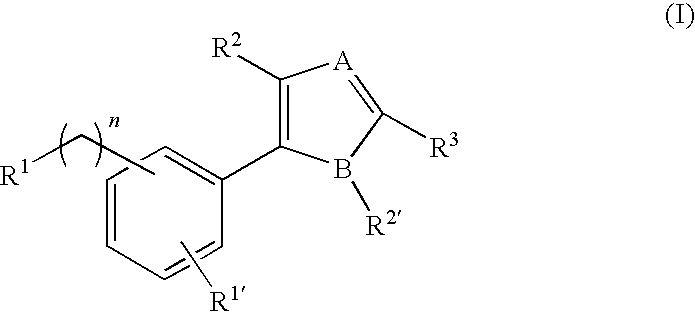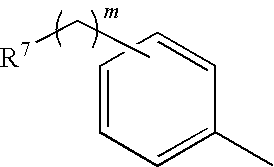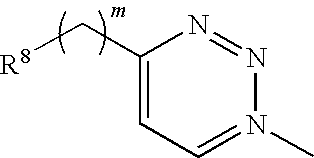Inhibition of bacterial biofilms with imidazole-phenyl derivatives
a technology of imidazole and derivatives, which is applied in the field of inhibiting bacterial biofilms with imidazolephenyl derivatives, can solve the problems of inability to eradicate infections of indwelling medical devices, deleterious effects of biofilms in non-medical settings, and serious problems for patients. , to achieve the effect of preventing, inhibiting, or removing a biofilm
- Summary
- Abstract
- Description
- Claims
- Application Information
AI Technical Summary
Benefits of technology
Problems solved by technology
Method used
Image
Examples
example 1
[0453]Synthesis of a 2-Aminoimidazole Library for Anti-Biofilm Screening Utilizing the Sonogashira Reaction. The synthesis of a 21 member library is described that employs a high-yielding Sonogashira reaction (Sonogashira et al., Tet. Lett. 1975, 4467-4470; Chinchilla et al., Chem. Rev. 2007, 107, 874-922; Schnurch et al., European Journal of Organic Chemistry 2006, 3283-3307) on three aryl iodide protected 2-aminoimidazole scaffolds to generate small molecules for screening as anti-biofilm agents.
[0454]Access to the desired aryl halide intermediates for the Sonogashira coupling was executed through the commercially available ortho, meta, and para substituted iodobenzoic acid derivatives 3-5 (Scheme 1).
[0455]
[0456]Each was first transformed into its acid chloride before being sequentially reacted with diazomethane and quenched with concentrated HBr. This afforded the requisite α-bromo ketones 6-8 in excellent yields. Installation of the 2-aminoimidazole subunit was achieved through ...
example 2
Synthesis of 2-Aminoimidazole Libraries for Anti-Biofilm Screening
[0464]Additional libraries are prepared as detailed in Scheme 4.
[0465]
example 3
[0466]Activity testing of compounds against A. baumannii. Biofilm inhibition assays were performed by taking an overnight culture of bacterial strain and subculturing it at an OD600 of 0.10 into LB medium. The compound being tested was then added at a predetermined concentration and then aliquoted (100 μL) into the wells of a 96-well PVC microtiter plate (Wells not used for samples were filled with 100 μL of de-ionized water). Plates were then wrapped in GLAD Press n' Seal® and incubated under stationary conditions at 37° C. After 24 hours, the media was discarded from the wells and the plates were washed thoroughly with tap water. Plates were then stained with 100 μL of 0.1% solution of crystal violet (CV) and then incubated at an ambient temperature for 30 minutes. Sample plates were then washed with tap water again, and the remaining stain was solubilized with 200 μL of 95% ethanol. Biofilm inhibition was quantitated by measuring the OD540 for each well by transferring 125 μL of ...
PUM
 Login to View More
Login to View More Abstract
Description
Claims
Application Information
 Login to View More
Login to View More - R&D
- Intellectual Property
- Life Sciences
- Materials
- Tech Scout
- Unparalleled Data Quality
- Higher Quality Content
- 60% Fewer Hallucinations
Browse by: Latest US Patents, China's latest patents, Technical Efficacy Thesaurus, Application Domain, Technology Topic, Popular Technical Reports.
© 2025 PatSnap. All rights reserved.Legal|Privacy policy|Modern Slavery Act Transparency Statement|Sitemap|About US| Contact US: help@patsnap.com



